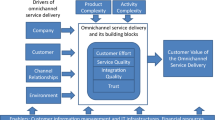Abstract
Improved understanding of how interactions between service providers and customers create value, along with advances in technology, can expand and redefine the roles of both provider and customer in the service delivery process. The traditional boundary between provider and customer can shift toward self service, with the customer performing many of the tasks previously done by the provider, as in self-service check-in at the airport or self-serve salad bars in restaurants. Alternatively, the boundary can shift in the opposite direction—toward what we define as super service—with the provider performing many tasks previously done by the customer, such as a car rental company that delivers vehicles to customers or automatic bill paying services provided by banks. Why do providers shift this boundary in one direction or the other? Increased competition, changing customer attitudes, and new technologies all contribute to the development of new self-service and new super-service delivery configurations. But these new configurations are only effective when they can create additional value for both provider and customer. In this paper, we introduce a resource mapping framework for shifting the service boundary effectively. This framework allows us to examine the continuum of options from self service to super service from a service systems perspective to identify conditions under which shifting the provider-customer boundary creates value.


Similar content being viewed by others
References
Bitner MJ, Ostrom AL, Meuter ML (2002) Implementing successful self-service technologies. Acad Manage Exec 16(4):96–109
Bitner MJ, Ostrom AL, Morgan FN (2008) Service blueprinting: a practical technique for service innovation. Calif Manage Rev 50(3):66–94
Cline K (2004) Institutionalizing innovation. Bank Administration Institute 80(5)
Dabholkar PA (1996) Consumer evaluation of new technology-based self-service options: an investigation of alternative model of service quality. Int J Res Mark 13:29–51
Evenson S, Dubberly H (2010) Designing for service: creating an experience advantage. In: Karwowski W, Salvendy G (eds) Introduction to service engineering. Wiley, New York, pp 403–413
Gamma E, Helm R, Johnson R, Vlisiddes J (1994) Design patterns: elements of reusable object-oriented software. Addison Wesley, New York
Glushko RJ (2010) Seven contexts for service system design. In: Maglio PP, Kieliszewski CA, Spohrer JC (eds) Handbook of service science. Springer, New York, pp 219–249
Harmon A (2003) More consumers reach out to touch the screen. The New York Times, Nov 17
Holden SH, Norris DF, Fletcher PD (2002) Electronic government at the grass roots: contemporary evidence and future trends. In: Proceedings of the 36th Hawaii international conference on systems sciences, vol 5. p 134c
Lovelock C (1994) Product plus: how product + productivity = competitive advantage. McGraw-Hill, Inc., New York, p 57
Maglio PP, Spohrer J (2008) Fundamentals of service science. J Acad Mark Sci 36:18–20
Maglio PP, Vargo SL, Caswell N, Spohrer J (2009) The service system is the basic abstraction of service science. Inform Syst e-bus Manage 7:395–406
Meuter ML, Ostrom A, Bitner MJ, Roundtree R (2003) The influence of technology anxiety on consumer use and experiences with self-service technologies. J Bus Res 56(11):899–906
Moon Y, Frei FX (2000) Exploding the self-service myth. Harv Bus Rev 78(3):26–27
Morris J, Maglio PP (2001) When buying on-line, does price really matter? In: CHI ‘01 extended abstracts on human factors in computing systems, pp 343–344
Normann R (2001) Reframing business: when the map changes the landscape. Wiley, New York
Normann R, Ramirez R (1993) From value chain to value constellation: designing interactive strategy. Harv Bus Rev 71:65–77
Norris DF, Holden SH, Fletcher PD (2001) E-Government: web sites and web access. Special Data Issue No. 4. ICMA Press, Washington, DC
Quinn JB, Hilmer FG (1994) Strategic outsourcing. Sloan Manage Rev 4:43–55
Schneider B, Bowen DE (1995) Winning the service game. Harvard Business School Press, Boston
Shostak GL (1984) Designing services that deliver. Harv Bus Rev 62:133–139
Spohrer J, Maglio PP (2008) The emergence of service science: toward systematic service innovations to accelerate co-creation of value. Prod Oper Manage 17(3):1–9
Spohrer J, Maglio PP (2010) Service science: toward a smarter planet. In: Karwowski W, Salvendy G (eds) Introduction to service engineering. Wiley, New York, pp 3–30
Spohrer J, Maglio PP, Bailey J, Gruhl D (2007) Towards a science of service systems. Computer 40(1):71–77
Sprecher MH, Talcove H, Bowen D (1996) Local government technology survey released. Gov Technol 1:47–49
Vargo SL, Lusch RF (2004) Evolving to a new dominant logic for marketing. J Mark 68:1–17
Author information
Authors and Affiliations
Corresponding author
Rights and permissions
About this article
Cite this article
Campbell, C.S., Maglio, P.P. & Davis, M.M. From self-service to super-service: a resource mapping framework for co-creating value by shifting the boundary between provider and customer. Inf Syst E-Bus Manage 9, 173–191 (2011). https://doi.org/10.1007/s10257-010-0142-4
Received:
Accepted:
Published:
Issue Date:
DOI: https://doi.org/10.1007/s10257-010-0142-4




